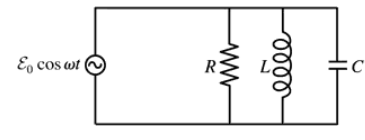An AC source operates at a maximum voltage of 120 V and an angular frequency of 377 s-1 . If this source is connected in parallel to a 15 Ω resistor and in parallel to a 0.20 mF capacitor, answer the following questions:
a) What is the maximum current produced by the source?
b) What is the maximum current through the resistor?
c) What is the maximum current through the capacitor?







